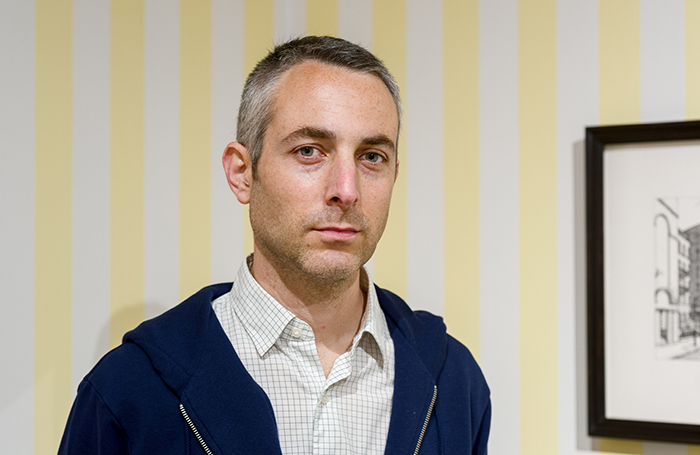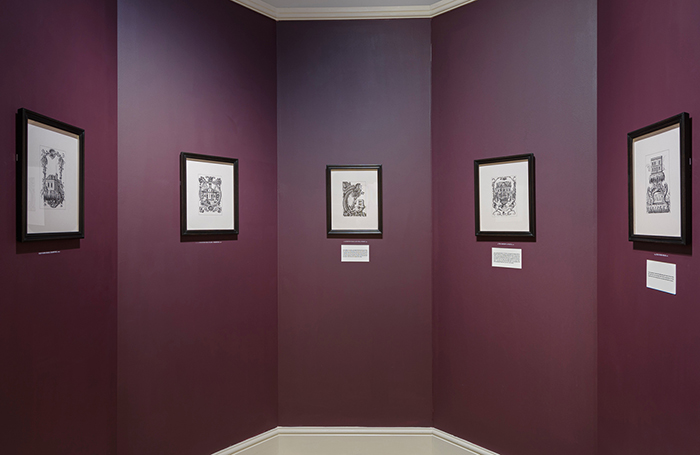The artist, whose exhibition, 'Pablo Bronstein: Conservatism, or The Long Reign of Pseudo-Georgian Architecture', is currently on show at the RIBA, talks to Shumi Bose about early and current influences on his work, in an excerpt from issue 7 of 'A Magazine' for RIBA Friends of Architecture.

Shumi Bose Pablo, you’re about to have two major exhibitions of your work. Your show at the RIBA on what you have dubbed ‘Pseudo-Georgian’ has recently opened. What is the other exhibition that you are working on?
Pablo Bronstein The forthcoming show is in Turin, at Galleria Franco Noero, opening in just a month. It’s about China.
SB Is this a topic or an interest you’ve been cultivating for a while?
PB Yes, I’ve always loved China, both real and fake China … The Turin show addresses a Western historical view of China as a threat, as an object of fascination and fear, or at least suspicion. For a very long time, all we really knew of China was that it was extremely large and very sophisticated.
I think that it might have been similar to the way we might have viewed Mars in the early twentieth century. Obviously we knew in the sixteenth or seventeenth centuries that we could get to China, but in the early part of the twentieth century, we were fairly certain it was conceivable to get to Mars, too.
SB Our knowledge of China must have been so abstract and just as alien.
PB Well, we got objects back from China, and we’ve always been in thrall of its technical accomplishments in porcelain manufacture, for example. That has clearly always amazed the West. But I think it’s no coincidence that the Flash Gordon comic strip has both the planet Mongo, which is a Martian-like land, and Ming the Merciless – that parallel of otherness makes sense to me.
So you get an appreciation of technology, and a suspicion of its scale. Somehow or other, China doesn’t quite need or fear the Western gaze so much – we’ve always had a sense of its might and confidence, of an older and perhaps more powerful civilisation. But in fact there is almost a reciprocal gaze from China.
There are all these fantastical Western-style palaces that were created (and then destroyed by the French in the 1860s) for the Chinese Imperial family, which fetishised Western culture.
SB What style of architecture was the most fascinating for them? And what are you drawing for the show?
PB I think the Chinese mostly favoured a kind of overblown Baroque, and they would have all of these rarities and things brought in from Europe. While we had chinoiserie, as a kind of fetishised style, China had its own fascination with all things European.
I had already been looking at our relationship with China through available materials, patterns, textures and so on – the way that this culture has been brought into the Western decorative idiom. But now I’m really thinking more about a historic perception of China as a kind of science fiction, a Martian terrain.
SB I’ve read that you drew prodigiously as a very young child.
PB Apparently I drew compulsively, but I’m sure it was just scribbles. I do remember one drawing which involved what seemed like an astonishing degree of technological and psychological prowess: I managed to make a ladies’ necklace look three-dimensional, generating a sense of solidness in the beads – it looked like it was going around and disappearing behind the neck.
SB You spent your childhood split between Buenos Aires and north London. How was that?
PB Yes, a lot of my childhood was spent between both places, so it’s sometimes hard to place my memories. In Argentina, there was this crumbling kind of Beaux-Arts, fin-de-siècle glory – and then it moved quickly into a sort of midcentury Latin Modernism.
SB And where were you in London? That must have been a strange contrast.
PB Well, yes, London definitely felt smaller, less grand, than Buenos Aires; everything was low and suburban. We were in Willesden, and later Dollis Hill – a world of uninteresting Victorian and Edwardian semis. But you know, for people from other places, that image of pitched roofs and red-brick houses is equally exotic and desirable.

SB Tell me a bit about how you came to draw buildings as an adult.
PB Well, I was at the Bartlett School of Architecture, but only for about three weeks. It wasn’t for me. When I started at art school, a fellow student told me I couldn’t possibly make work just about buildings, which felt extraordinarily oppressive, but I believed it for a while. Then at the Slade I had a little rebellion and started painting buildings, and drawing rather detailed theatrical stagesets.
At Goldsmiths I learned to make videos and the usual institutional critiques that art students make, before finally returning – again rebelliously – to drawing architecture.
SB A more determined return, perhaps. Is that when you were making those almost Aldo Rossi-like paintings of fragments? Those early works are quite different from your pen-and-ink drawings today.
PB It was a couple of years earlier, around 2002–3 … These were the first drawings I had made of buildings since the Slade, and they were unbelievably primitive in terms of technique, but it was revelatory to be able to pursue that practice. There was no one to teach me any kind of basic skills, but you do pick things up – like learning how to draw a straight line with a dip-pen and ink.
SB So you never sat with an architect to learn about technical drawing? I suppose your drawings are more about presentation, the way that buildings present themselves.
PB Well, one of the reasons that my drawings had some appeal to architects at the time was because they chimed with a generation who had not been brought up on computers – the last ones to use colouring pencils and pens and things like that – and that was in the late eighties.
Things radically changed after that; there was a seismic shift. And I think I deliberately nostalgised that, with these Rossilike sketches, and these new–old, postmodern conjunctions.
SB Insofar as building goes, how much does a large, permanent project like The Rose Walk at Jupiter Artland [Edinburgh, 2017] approximate a work of architecture?
PB Well, architecturally speaking, it’s boring. It’s just two pavilions connected with a passageway, facing into each other. The long passageway between them is lined with roses. It is divided strictly down the middle; one side is Chinese, and the other side is Gothic, so if you walk in through the Chinese side, you’ll see the Gothic pavilion opposite, and vice versa. And it’s made of something that simulates trellis-work, but is actually of laser-cut steel.
Ideally, it should feel like plate-book architecture. In an eighteenth century pattern book, you would have been able to choose between various exotic or historic styles, be it Chinese, Gothic, Turkish or whatever, and these were the two most popular styles at the time.
SB So they are supposed to look like two completely independent designs, like a spread in a pattern book? You would never generally get such opposing styles together, I suppose.
PB Exactly. The sort of self-devouring aspect of them facing each other is quite important. It’s all very kitsch, it’s not a serious bit of architecture at all. People take selfies, either in the Gothic or the Chinese pavilions, depending on which way they’re looking … I suppose it’s a statement about drawing, and the purchase of visual identity in the landscape. But as architecture, it’s nothing.
SB The purchase of visual identity, that’s very interesting. I certainly feel that’s also a strong theme of the Pseudo-Georgian show at the RIBA. What do you think you’re trying to do with these exhibitions? Are you trying to say something, or do exhibitions simply offer a catharsis of a particular topic for you?
PB I get asked this quite often, particularly outside the contemporary art world. I think this question of ‘What are you trying to do?’ is more for a curator, really. When you’re given a show you have to fix the ideas in your work, synthesise a title, a coherence.
My process can be quite solitary and individual, and to some extent that’s been a salvation of my practice – I’m often surprised when someone asks me why I’ve made something.
SB To me your practice seems so consistent – not the format or topic, but the direction it is coming from in terms of critique, and particularly how you talk about architecture, your perception of it and so on. Your interest in postmodernism, for example, anticipated a similar revival within the architectural community around 2014 or so.
PB Well, except for those guys from FAT, who were just crazy, and working on it earlier than I was. My book on Postmodernism ['Postmodern Architecture in London', published 2007] was made in 2006, while they were doing this stuff in the late nineties, just a few years from it being a current style. But it did take until the noughties before they found recognition.
SB Yes, barely had postmodernism had a chance to sleep before they satirised it – though it was always the ironically trashy guest at the table. Nonetheless, at the time it seemed as though you were being very responsive, on the pulse.
The current show at the RIBA could also seem contemporary – addressing London housing stock, ideas of national identity and taste; even the China show in Turin could be seen to address globalisation and cultural flows.
PB When you come and see the 50 drawings I’ve made for the Pseudo-Georgian show, it doesn’t really give you an idea of the historic importance of this style on an academic level. We who make things that look nice, or who deal with the visual register, we’re not always that clever.
The fact that we’ve included historic works from the RIBA Drawings Collection adds something – but I do think there is a case to be made for shining a torch on what exists, and saying this is what we have. There is a parallel tendency to try and understand something, and simply looking at it formally or aesthetically.
I’ve been talking to the RIBA about this show since 2014. We only really got it together and crystallised it when we realised that I wasn’t talking about Neo-Georgian architecture, but rather this thing we’ve decided to call Pseudo- Georgian. I had been drawing this stuff anyway. But other architectural critics have said the same to me, about my practice feeling current or contemporaneous – maybe you are able to see something that I can’t.
SB To finish with, what’s your favourite part of the process, in making these incredible hand drawings?
PB Well, I use photographs, visits, images sent by friends or found online, but that’s to get a basic understanding of the building. The real pleasure comes when I’m able to build up the richness of the line, the thickness of embellishment.
SB I know you’ve got more worlds to draw – or, rather, more strange bits of this one.
'Pablo Bronstein: Conservatism, or The Long Reign of Pseudo-Georgian Architecture’ is at the RIBA, 66 Portland Place, until 11 February 2018.









